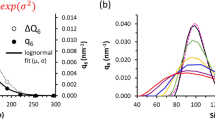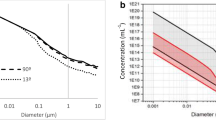Abstract
Small angle scattering can provide unique structural information on the shape, domain organisation, and interactions of biomacromolecules in solution. Small angle neutron scattering (SANS) combined with deuterium labelling makes it possible to define the positions of specific components within a complex while small angle X-ray scattering (SAXS) provides more precise data on the overall shape. Here I review four recent publications, three of which were presented at the Neutrons in Biology meeting at the STFC Rutherford Appleton Laboratory in July 2007, that utilise SANS, SAXS, and complementary techniques to define the solution structure of large multidomain proteins and macromolecular complexes. These four papers emphasise the critical importance of sample quality and characterisation as well as the important role played by complementary techniques in building structural models based on small angle scattering data. They show the ability of SANS and SAXS in determining solution structures provides an important complementary structural technique for large, flexible, and glycosylated proteins where high resolution structural techniques, such as crystallography and NMR, cannot be applied.




Similar content being viewed by others
References
Ashton AW, Boehm MK, Gallimore JR, Pepys MB, Perkins SJ (1997) Pentameric and decameric structures in solution of serum amyloid P component by X-ray and neutron scattering and molecular modelling analyses. J Molec Biol 272:408–422
Bickle TA, Kruger DH (1993) Biology of DNA restriction. Microbiol Rev 57:434–450
Boehm MK, Perkins SJ (2000) Structural models for carcinoembryonic antigen and its complex with the single-chain Fv antibody molecule MFE23. FEBS Lett 475:11–16
Bonner A, Perrier C, Corthesy B, Perkins SJ (2007) Solution structure of human secretory component and implications for biological function. J Biol Chem 282:16969–16980
Boucard AA, Chubykin AA, Comoletti D, Taylor P, Sudhof TC (2005) A splice code for trans-synaptic cell adhesion mediated by binding of neuroligin 1 to α- and β-neurexins. Neuron 48:229–236
Brunger AT, Adams PD, Clore GM, DeLano WL, Gros P, Grosse-Kunstleve RW, Jiang J-S, Kuszewski J, Nilges M, Pannu NS, Read RJ, Rice LM, Simonson T, Warren GL (1998) Crystallography & NMR system: a new software suite for macromolecular structure determination. Acta Cryst D Biol Crystalogr 54:905–921
Burkholder WF, Kurtser I, Grossman AD (2001) Replication initiation proteins regulate a developmental checkpoint in Bacillus subtilis. Cell 104:269–279
Calisto BM, Pich OQ, Pinol J, Fita I, Querol E, Carpena X (2005) Crystal structure of a putative type I restriction-modification s subunit from Mycoplasma genitalium. J Molec Biol 351:749–762
Callow P, Sukhodub A, Taylor JE, Kneale GG (2007) Shape and subunit organisation of the DNA methyltransferase M.AhdI by small-angle neutron scattering. J Molec Biol 369:177–185
Chih B, Engelman H, Scheiffele P (2005) Control of excitatory and inhibitory synapse formation by neuroligins. Science 307:1324–1328
Comoletti D, Flynn R, Jennings LL, Chubykin A, Matsumura T, Hasegawa H, Sudhof TC, Taylor P (2003) Characterization of the interaction of a recombinant soluble neuroligin-1 with neurexin-1β. J Biol Chem 278:50497–50505
Comoletti D, Flynn RE, Boucard AA, Demeler B, Schirf V, Shi J, Jennings LL, Newlin HR, Sudhof TC, Taylor P (2006) Gene selection, alternative splicing, and post-translational processing regulate neuroligin selectivity for β-neurexins. Biochemistry 45:12816–12827
Comoletti D, Grishaev A, Whitten AE, Tsigelny I, Taylor P, Trewhella J (2007) Synaptic arrangement of the neuroligin/β-neurexin complex revealed by X-ray and neutron scattering. Structure 15:693–705
Dean C, Dresbach T (2006) Neuroligins and neurexins: linking cell adhesion, synapse formation and cognitive function. Trends Neurosci 29:21–29
Gill SC, Hippel PHv (1989) Calculation of protein extinction coefficients from amino-acid sequence data. Anal Biochem 182:319–326
Grishaev A, Wu J, Trewhella J, Bax A (2005) Refinement of multidomain protein structures by combination of solution small-angle X-ray scattering and NMR Data. J Am Chem Soc 127:16621–16628
Hamburger AE, West AP, Bjorkman PJ (2004) Crystal structure of a polymeric immunoglobulin binding fragment of the human polymeric immunoglobulin receptor. Structure 12:1925–1935
Hoffman RC, Jennings LL, Tsigelny I, Comoletti D, Flynn RE, Sudhof TC, Taylor P (2004) Structural characterization of recombinant soluble rat neuroligin 1: mapping of secondary structure and glycosylation by mass spectrometry. Biochemistry 43:1496–1506
Hu Y, Sun Z, Eaton JT, Bouloux PMG, Perkins SJ (2005) Extended and flexible domain solution structure of the extracellular matrix protein anosmin-1 by X-ray scattering, analytical ultracentrifugation and constrained modelling. J Molec Biol 350:553–570
Kim J-S, DeGiovanni A, Jancarik J, Adams PD, Yokota H, Kim R, Kim S-H (2005) Crystal structure of DNA sequence specificity subunit of a type I restriction-modification enzyme and its functional implications. Proc Natl Acad Sci USA 102:3248–3253
Lisé MF, El-Husseini A (2006) The neuroligin and neurexin families: from structure to function at the synapse. Cellular Molec Life Sci (CMLS) 63:1833–1849
Marina A, Waldburger CD, Hendrickson WA (2005) Structure of the entire cytoplasmic portion of a sensor histidine–kinase protein. Embo J 24:4247–4259
Mostov KE, Friedlander M, Blobel G (1984) The receptor for transepithelial transport of IgA and IgM contains multiple immunoglobulin-like domains. Nature 308:37–43
Pace CN, Vajdos F, Fee L, Grimsley G, Gray T (1995) How to measure and predict the molar absorption coefficient of a protein. Protein Sci 4:2411–2423
Perkins SJ (1986) Protein volumes and hydration effects. The calculations of partial specific volumes, neutron scattering matchpoints and 280-nm absorption coefficients for proteins and glycoproteins from amino acid sequences. Eur J Biochem 157:169–180
Perkins SJ, Bonner A (2008) Structure determinations of human and chimaeric antibodies by solution scattering and constrained molecular modelling. Biochem Soc Trans (in press)
Perkins SJ, Gilbert HE, Aslam M, Hannan J, Holers VM, Goodship TH (2002) Solution structures of complement components by X-ray and neutron scattering and analytical ultracentrifugation. Biochem Soc Trans 30:996–1006
Petoukhov MV, Svergun DI (2005) Global rigid body modeling of macromolecular complexes against small-angle scattering data. Biophys J 89:1237–1250
Petoukhov MV, Svergun DI (2006) Joint use of small-angle X-ray and neutron scattering to study biological macromolecules in solution. Eur Biophys J 35:567–576
Petoukhov MV, Svergun DI (2007) Analysis of X-ray and neutron scattering from biomacromolecular solutions. Curr Opin Struct Biol 17:562–571
Rajashankar K, Kniewel R, Lima C, Burley S (2005) Crystal structure of Type I restriction enzyme EcoKI M protein (EC 2.1.1.72) (M.EcoKI). Protein Data Bank
Rowland SL, Burkholder WF, Cunningham KA, Maciejewski MW, Grossman AD, King GF (2004) Structure and mechanism of action of Sda, an inhibitor of the histidine kinases that regulate initiation of sporulation in Bacillus subtilis. Molec Cell 13:689–701
Stuhrmann HB (2004), Unique aspects of neutron scattering for the study of biological systems. Rep Prog Phys 67:1073–1115
Svergun DI (1999) Restoring low resolution structure of biological macromolecules from solution scattering using simulated annealing. Biophys J 76:2879–2886
Trewhella J (2006) Neutrons reveal how nature uses structural themes and variation in biological regulation. Physica B 385–386:825–830
Varughese KI, Tsigelny I, Zhao H (2006) The crystal structure of beryllofluoride Spo0F in complex with the phosphotransferase Spo0B represents a phosphotransfer pretransition state. J Bacteriol 188:4970–4977
Whitten AE, Jacques DA, Hammouda B, Hanley T, King GF, Guss JM, Trewhella J, Langley DB (2007) The structure of the KinA–Sda complex suggests an allosteric mechanism of histidine kinase inhibition. J Molec Biol 368:407–420
Yamagata M, Sanes JR, Weiner JA (2003) Synaptic adhesion molecules. Curr Opin Cell Biol 15:621–632
Acknowledgments
The author would like to thank Professor Stephen Perkins, Professor Jill Trewhella, and Dr Andrew Whitten for comments on the manuscript.
Author information
Authors and Affiliations
Corresponding author
Additional information
Advanced neutron scattering and complementary techniques to study biological systems. Contributions from the meetings, “Neutrons in Biology”, STFC Rutherford Appleton Laboratory, Didcot, UK, 11–13 July and “Proteins At Work 2007”, Perugia, Italy, 28–30 May 2007.
Rights and permissions
About this article
Cite this article
Neylon, C. Small angle neutron and X-ray scattering in structural biology: recent examples from the literature. Eur Biophys J 37, 531–541 (2008). https://doi.org/10.1007/s00249-008-0259-2
Received:
Revised:
Accepted:
Published:
Issue Date:
DOI: https://doi.org/10.1007/s00249-008-0259-2




